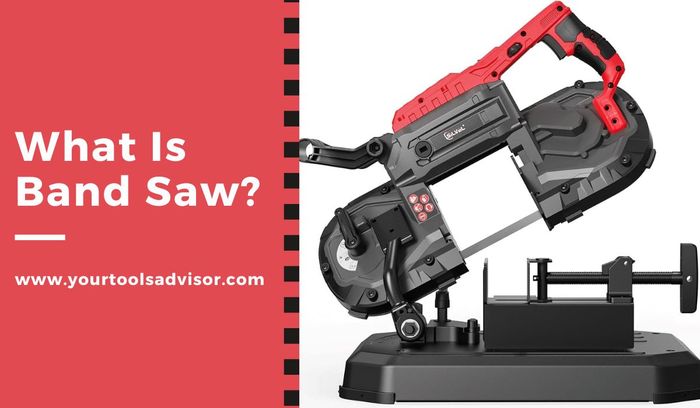In the world of woodworking, there exists a versatile and indispensable tool that has earned its place in the workshops of both amateurs and seasoned craftsmen alike.
Enter the world of band saw – a powerful and precision-driven machine that plays a pivotal role in shaping raw materials into exquisite pieces of artistry.
If you’re new to the woodworking scene or looking to expand your knowledge, understanding the ins and outs of a band saw is an essential step towards honing your craft.
In this comprehensive guide, we’ll unravel the mysteries surrounding the band saw, shedding light on its components, functions, and the myriad of applications it offers to woodworkers of all levels.
From its inception to its modern-day adaptations, we’ll take you on a journey through the evolution of this remarkable tool, highlighting its significance in the realm of woodworking.
Whether you’re a hobbyist, a DIY enthusiast, or a professional woodworker, this blog post aims to demystify the band saw, providing you with the knowledge and confidence needed to make the most out of this invaluable addition to your workshop.
So, let’s embark on this exploration together, as we delve into the world of the band saw and unlock its full potential in your woodworking endeavors….
Overview Of A Band Saw
A band saw is a versatile and powerful cutting tool utilized in various industries for precisely cutting different materials such as wood, metal, and plastic. It consists of a continuous, toothed metal blade, known as a band, which is stretched between two wheels and driven by an electric motor.
The blade moves in a continuous loop, allowing for smooth and efficient cutting in straight or curved lines. With its exceptional cutting capabilities, a band saw is an indispensable tool for craftsmen, carpenters, metalworkers, and DIY enthusiasts.
What Is Band Saw?
A band saw is a cutting tool that employs a thin, sharp bandsaw blade set on wheels to perform precise cutting operations. The blade moves in a continuous loop, allowing for smooth and accurate cutting in various directions. The primary function of a band saw is to cut different types of materials with precision and control.
Different Types Of Band Saws
Band saws are available in several different types, each catering to specific cutting requirements.
The main types of band saws are:
- Vertical band saws
- Horizontal band saws
- Portable band saws
Vertical Band Saws
Vertical band saws are designed with a vertically oriented worktable. These band saws are commonly used for cutting intricate shapes, curves, and irregular patterns in wood, metal, or plastic. They offer excellent maneuverability and visibility, making them ideal for detailed cutting tasks.
Horizontal Band Saws
Horizontal band saws, as the name suggests, have a horizontally positioned worktable. These band saws are commonly used for cutting materials such as metal bars, pipes, and other long workpieces. The horizontal orientation of the blade enables efficient straight-line cutting.
Portable Band Saws
Portable band saws are compact and lightweight, allowing for easy transportation and mobility. These band saws are perfect for on-site cutting tasks, such as plumbing, electrical work, and construction projects. Portable band saws provide the convenience of versatile cutting capabilities in a portable form factor.
Read More: How Do You Use A Portable Band Saw?
Applications Of Band Saws In Various Industries
A band saw finds extensive applications across a range of industries, including but not limited to:
- Woodworking Industry: Band saws are commonly used for cutting lumber, creating intricate designs, and shaping woodwork.
- Metalworking Industry: Band saws are used for accurately cutting metal sheets, bars, tubes, and profiles.
- Plastic Industry: Band saws are employed to cut and shape plastic materials for various applications.
- Construction Industry: Band saws assist in cutting materials such as pipes, tiles, and stone for construction purposes.
- Automotive Industry: Band saws are utilized for cutting metal components in auto body repair and customization.
With their versatility, efficiency, and precision, band saws have become an indispensable tool in numerous industries, delivering high-quality cutting results and enhancing productivity.
Components Of A Band Saw
A band saw is a versatile woodworking tool that consists of various components working together to deliver accurate and efficient cutting. Understanding the different parts of a band saw is essential to make the most out of this powerful tool.
In this article, we will explore the key components of a band saw and their importance in achieving precise and high-quality cuts.
The Blade
The blade is the heart of a band saw, responsible for making the actual cuts. It is a continuous metal band with teeth along one edge. Band saw blades come in different sizes and tooth configurations to suit various cutting needs.
Types of Band Saw Blades
- Regular Tooth Blades: Ideal for general-purpose cutting and can handle different materials. They have a tooth pattern with equal space between each tooth.
- Hook Tooth Blades: Primarily used for cutting softer materials, as they have fewer teeth per inch and a larger gullet, allowing for faster cutting and removal of sawdust.
- Skip Tooth Blades: These blades have widely spaced teeth which help prevent clogging when cutting through thicker materials such as hardwoods or plastics.
Blade Material and Tooth Configuration
The material and tooth configuration of the band saw blade are crucial factors in determining the cutting performance. Common materials for the blade include carbon steel, bi-metal, and carbide-tipped. Each material has its own advantages and is suitable for different applications.
The Frame
The frame provides stability and support to the band saw, ensuring accurate and smooth cuts.
Material and Construction of the Frame
The frame of a band saw is typically made of cast iron or welded steel. Cast iron frames are heavier and more stable, reducing vibrations during cutting.
On the other hand, welded steel frames are lighter and more affordable, making them suitable for occasional users.
The Motor And Drive System
The motor and drive system are responsible for powering the band saw and controlling its cutting speed.
Power Requirements for Band Saws
Band saws come in a range of sizes and power ratings. The power requirements depend on the size of the machine and the materials to be cut. Larger band saws usually require more powerful motors to maintain cutting efficiency.
Variable Speed Control Options
Some band saws offer variable speed control, allowing users to adjust the cutting speed according to the material being cut. This feature offers flexibility and helps achieve optimal results regardless of the material’s thickness or hardness.
Table And Fence
The table and fence provide support and guidance to the workpiece during cutting, ensuring accuracy and safety.
Types of Tables Available
Band saws can have different types of tables, such as cast iron, aluminum, or steel. The table should be flat and sturdy to provide a stable platform for the workpiece.
Importance of Solid Fence for Precision Cutting
The fence is an adjustable guide that helps maintain a consistent distance between the blade and the edge of the workpiece. A solid fence is essential for precision cutting, ensuring straight and parallel cuts.
By understanding the components of a band saw and their importance, you can make informed decisions when choosing or operating this powerful woodworking tool.
Whether you are a professional woodworker or a DIY enthusiast, a well-maintained band saw can greatly enhance your cutting capabilities, enabling you to achieve precise and high-quality results.
How Does A Band Saw Work?
A band saw is a versatile power tool that is commonly used in woodworking, metalworking, and various other industries. It consists of a continuous toothed metal blade that moves in a continuous loop, wrapped around two or more wheels.
The band saw has the ability to make straight cuts, curved cuts, and even angled cuts, making it a valuable tool for many different applications.
Blade Tensioning And Tracking
One important aspect of a band saw is blade tensioning and tracking. Blade tensioning refers to the process of adjusting the tightness of the blade on the wheels. Proper blade tension is crucial for optimal cutting performance and safety. If the blade is too loose, it may wander or slip off the wheels, resulting in inaccurate cuts.
On the other hand, if the blade is too tight, it can lead to increased wear on the blade and the wheels. Adjusting the blade tension is a relatively straightforward process. Most band saws have a tensioning knob or lever that allows you to increase or decrease the tension.
It is important to ensure that the blade tension is evenly distributed across the length of the blade.
Adjusting Blade Tracking For Accurate Cuts
Proper blade tracking is essential for achieving accurate cuts. When the blade is aligned perfectly on the wheels, it will cut straight and stay on the intended cutting line. Adjusting the blade tracking may require some trial and error, especially when changing blades or using worn-out blades.
If the blade is tracking to one side, you can correct it by turning the tracking adjustment knob. Make small adjustments and observe the blade’s behavior until it runs smoothly and stays centered on the wheels.
It is important to monitor the blade tracking regularly, as it can shift over time due to blade changes or wear.
Cutting Techniques of Band Saw
Straight Cuts
Band saws excel at making straight cuts in various materials. To achieve precise straight cuts, follow these steps:
- Ensure the blade tension is properly adjusted.
- Adjust the blade tracking to keep the blade centered.
- Set the cutting speed appropriate for the material being cut.
- Position the material securely against the fence or miter gauge.
- Slowly guide the material through the blade, maintaining a steady feed rate.
Curved Cuts
Curved cuts require more finesse and control. Here’s how to make accurate curved cuts using a band saw:
- Choose a blade with a suitable width and tooth configuration for the desired curve.
- Trace the desired curve onto the material.
- Make relief cuts along the curve, spacing them close together.
- Carefully follow the curve, guiding the material through the blade.
- Take your time and make small, controlled movements to maintain the curve.
Angled Cuts
Band saws can also be used to make angled cuts. To achieve accurate angled cuts, consider the following steps:
- Adjust the table or workpiece to the desired angle.
- Secure the material in place to prevent movement during cutting.
- Ensure the blade is properly tensioned and tracked.
- Slowly feed the material through the blade, maintaining a consistent angle.
- Monitor the cut closely to ensure accuracy.
Benefits of A Band Saw
A band saw is a versatile cutting tool that offers a wide range of benefits across various industries and woodworking projects. One of the primary advantages of using a band saw is its exceptional precision and accuracy.
Unlike other cutting tools, a band saw utilizes a continuous loop of sharp teethed blades, allowing for smooth and precise cuts through a variety of materials such as wood, metal, plastic, and even foam. This level of precision is crucial for tasks like intricate woodworking, furniture making, and metalworking, where exact measurements and clean edges are paramount.
Additionally, a band saw provides greater flexibility in terms of the types of cuts it can make. With the ability to make both straight and curved cuts, a band saw is invaluable for creating intricate designs, shapes, and patterns.
Its ability to cut curves is especially advantageous for woodworking projects that require detailed and ornate work.
Furthermore, band saws are known for their efficiency and speed, allowing for faster and more productive work compared to manual sawing methods. This efficiency can lead to increased productivity in a workshop or production setting, ultimately saving both time and resources in the long run.
Overall, the precision, flexibility, and efficiency offered by a band saw make it an indispensable tool for professionals and hobbyists alike.
Maintenance Tips For Band Saws
Band saws are versatile cutting tools used in woodworking and metalworking. To keep them in top condition, regular maintenance and care are crucial.
In this section, we will discuss the key areas of maintenance and care for band saws, including blade maintenance and replacement, cleaning and lubrication, adjusting and aligning the blade, regular inspection for wear and tear, safety checks, and troubleshooting common issues.
Blade Maintenance And Replacement
Keeping your band saw’s blade sharp and in good condition is crucial for achieving precise cuts and preventing accidents.
Here are some essential tips for blade maintenance and replacement:
- Regularly inspect the blade for signs of dullness, wear, or damage. Replace the blade immediately if you notice any issues.
- Clean the blade after each use to remove debris and residue that can affect cutting performance.
- Follow the manufacturer’s guidelines for sharpening or replacing the blade. If you’re unsure, consult a professional.
- Always use the appropriate blade for the material you’re cutting to avoid premature wear and tear.
Cleaning And Lubrication
Maintaining cleanliness and proper lubrication is essential for smooth and efficient band saw operation.
Here are some tips for cleaning and lubricating your band saw:
- Regularly remove dust, chips, and other debris from the saw’s table, wheels, and guides.
- Use a brush or compressed air to clean hard-to-reach areas.
- Apply a suitable lubricant to the blade, guide bearings, and other moving parts according to the manufacturer’s recommendations.
- Wipe down the entire saw with a clean cloth to remove any excess lubricant or build-up.
Adjusting And Aligning The Blade
To achieve accurate cuts, it’s important to ensure that the band saw blade is properly adjusted and aligned.
Follow these steps:
- Check the tension of the blade. It should be taut, but not overly tight, to prevent premature wear.
- Inspect the blade guides and bearings, making sure they are properly aligned and adjusted for smooth operation.
- Verify that the blade is centered on the wheels and tracking properly. Make adjustments as necessary.
- Test the blade’s tracking by slowly rotating the wheels and watching for any deviation.
Regular Inspection For Wear And Tear
Regularly inspecting your band saw for signs of wear and tear is crucial for preventing potential issues.
Here are some key areas to inspect:
- Check for any cracks or damage on the blade, wheels, and other structural components.
- Inspect the machine’s motor, belts, pulleys, and electrical connections for any signs of wear or damage.
- Ensure all safety features, such as blade guards and emergency stop buttons, are intact and functioning properly.
Safety Checks And Troubleshooting Common Issues
Prioritizing safety is paramount when working with band saws.
Here are some safety checks and troubleshooting tips:
- Always wear appropriate personal protective equipment, including safety glasses, gloves, and hearing protection.
- Ensure the saw’s power supply is properly grounded and the electrical connections are secure.
- Inspect the blade guard and tension for proper positioning and function.
- Troubleshoot common issues, such as blade drift or excessive vibration, by referring to the manufacturer’s troubleshooting guide or seeking professional assistance.
FAQs On What Is Band Saw
What is the main purpose of a band saw?
The main purpose of a band saw is to cut various materials such as wood, metal, and plastic. It is a versatile tool used for making straight cuts, complex curves, and angled cuts.
What is a band saw used for in construction?
A band saw is commonly used in construction to make precise and curved cuts in various materials like wood, metal, and plastic. Its versatility makes it a valuable tool for tasks such as shaping beams, cutting pipes, and creating intricate designs in construction projects.
What is the difference between a band saw and a circular saw?
A band saw is a versatile tool used for curved and irregular cuts, while a circular saw is best for straight cuts. Band saws have a continuous blade and can cut through thicker materials, while circular saws have a rotating blade and are ideal for faster, precision cuts.
Why use band saw instead of table saw?
Band saws offer more versatility in cutting curves compared to table saws. They can easily make intricate cuts and shapes, making them ideal for intricate woodworking projects.
Additionally, band saws have a smaller kerf, which means less wastage of materials. They also provide smoother cuts and are safer for cutting irregular-shaped or thin materials.
What’s the difference between bandsaw and jigsaw?
A bandsaw is a stationary tool used for making straight and curved cuts in wood and other materials, while a jigsaw is a handheld tool used primarily for making intricate cuts in smaller pieces of wood and other materials.
Conclusion
To sum it up, a band saw is an essential tool for cutting various materials with precision and versatility. Its unique design and functionality make it a popular choice among woodworkers, metalworkers, and DIY enthusiasts.
By understanding its features and benefits, you can harness the power of this tool to unlock your creativity and complete projects with ease.
Invest in a reliable band saw today and enjoy the endless possibilities it offers for your crafting and construction needs.
So, why wait? Start transforming your ideas into reality with a band saw by your side.





Leave a Reply